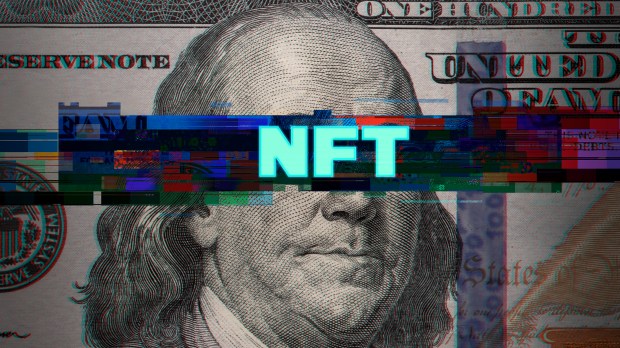In late November 2021, the Metaflower NFT was sold for 149 Ether tokens in The Sandbox. If you are not familiar with The Sandbox is (or if you don’t know yet what an NFT is), the transaction (“who bought what where with what?”) might seem completely irrelevant. However, it is anything but that. This purchase is, on the one hand, a revealing sample of how tech-driven economic trends are currently behaving. On the other, it is the index of a widening breach separating the real world and what is now being referred to as the metaverse —something that, not too long ago, was called cyberspace.
The Sandbox is a virtual gaming world where players can build, own, and monetize their gaming experience. A quick look at the Sandbox’s Twitter profile lets the user know what kind of assets are currently available for purchase: mainly, virtual estate auctions, lots of virtual land, and NFTs. NFT’s (Non-Fungible Tokens) are one-of-a-kind “things” that can be bought (or sold, or traded, or stored) on a blockchain. A blockchain, in turn, is a decentralized, distributed database shared among the nodes of a computer network, safely storing information (primarily transaction records) electronically. NFTs stored in these blockchains behave mostly like cryptocurrencies, yet with an important twist.
NFTs and virtual lavish “stuff”
Whereas cryptocurrencies are fungible (you can buy two Bitcoins, if you can afford it, and trade them for Ethereum and then buy your Bitcoins back if you want to, and you will get the same thing: Bitcoin), NFTs are non-fungible, unique. Pretty quickly, NFTs (which could be really anything in a digital format) became the new hype. “A lot of the current excitement,” Mitchell Clark explains, “is around using the tech to sell digital art […] A lot of the conversation is about NFTs as an evolution of fine art collecting, only with digital art.” Take, for example, a 50-second video by Grimes that was auctioned for almost $400,000. Or this other video, by Beeple, originally listed for $66,666 and auctioned for $66,600,000 almost a year ago. That’s $15,000,000 more than Monet’s waterlilies, as Clark notes. The 149 Ether tokens paid for The Metaflower are the cryptocurrency equivalent (or were, at the moment of the transaction) of roughly $650,000.
In the end, NFTs are speculative assets. Like any other speculative asset (stocks, metals, art, baseball cards) investors buy them expecting their price will eventually go up. The concept is, in that sense, not new at all. Several different online marketplaces allow people to buy and sell these NFTs. OpenSea is currently the first and largest of them all —at least according to their own website. And in case you are wondering, The Metaflower is a virtual mega-yacht “featuring two helipads, hot tubs, and a DJ booth, among other lavish facilities.”
If you think there is something unsettling about this, you are not alone. Articles like those of Jonathan Jones describe the allegedly art-related NFT craze as a wild monetization of digital culture that has nothing to do with boosting the careers of up-and coming digital artists. Instead, the NFT craze serves money (and the collector’s ego) for money’s sake. It is the climax of the speculative economy, Jones explains. And, as everything economic, things are a bit more complex than just saying “spending that amount of money on stuff is wrong.” One needs to look at the ways in which these economic dynamics are conceived and implemented, and how they transform the notion of value. How is value ascribed to these NFTs? Consider, for example, the case of Sultan Gustaf Al Ghozali, a 22-year-old computer science student from Semarang, Indonesia, who converted and sold nearly 1,000 selfie images as NFTs. According to Ghozali, he took photos of himself for five years — between the ages of 18 and 22 — as a way to look back on his graduation journey. He soon made around $1,000,000.
Metawhat, again?
The metaverse (whether Zuckerberg’s, The Sandbox, Minecraft, Warcraft, or any other) might appeal to some, maybe to millions, maybe even to most. However, the costs of accessing it (think of the gadgets users need just to log in, plus the minimum conditions of access to technology needed to do so, not to mention the purchase power needed to acquire one of these NFTs) will probably worsen already existing social and economic, gaps.As William Gibson once put it, “the future is already here; it’s just unevenly distributed.” It is not only a matter of asking if you need to buy an NFT or not. It is rather a question of whether or not these NFTs will define a major part of our already tech-driven economies.
Keza MacDonald is right in saying that virtual worlds can (or could) be “incredibly liberating.” The overall promise of cyberspace (now rebranded “metaverse”) has been that “it makes us all equal, allowing us to be judged not by our physical presentation or limitations, but by what’s inside our heads, by how we want to be seen. The dream is of a virtual place where the hierarchies and limitations of the real world fall away, where the nerdy dweeb can be the hero, where the impoverished and bored can get away from their reality and live somewhere more exciting, more rewarding.” The case of Al Ghozali and his $1MM NFT selfies seems to prove this is the case, but it seems to be an exception. As MacDonald says, “anyone who is marginalized in the real world, though, knows that this is not how things go down. Virtual worlds are not inherently any better than the real one.” As Sergio Olmos explains, what the promoters of the metaverse keep on turning a blind eye to is the fact that virtually no one will want to log in just to replicate his or her own already existing imperfect state. “The metaverse will either be the most successful aesthetic surgery procedure of all times or it won’t be anything at all,” Olmos claims. It might eventually lead to an ideal “Aryan world” —Aryan here meaning, according to Olmos, “whatever is fashionable at the moment.”
The idea that a metaverse (and its allegedly decentralized NFT trading market) will solve any of the problems of the real world is also rather naïve. MacDonald explains multiverses cannot but “reflect the people that make them,” “people to whom the problems of the real world are mostly invisible.” To begin with, no single major tech company has yet found a way to effectively moderate anything online (from hate commentaries on a blog to widely spread fake news campaigns) to keep their platforms free from manipulation and abuse. Sure, the multiverse can be used to “visit” your grandfather, “attend” a concert, “go to the office,” or sell your own unique NFTs. But it can obviously be used for less innocent purposes. Why wouldn’t that be the case, considering what has already happened with Facebook?
These metaverses are not promising new frontiers for humanity. At least, not for now. They are not using these resources to make online education widely available, to collect resources to bridge the tech gap, or to raise funds to alleviate real world problems. So far, the multiverse is yet another marketplace to spend money on things, “except in this place the empty promise that buying stuff will make you happy,” as MacDonald puts it, “is left even more exposed by the fact that the things in question do not physically exist.”



